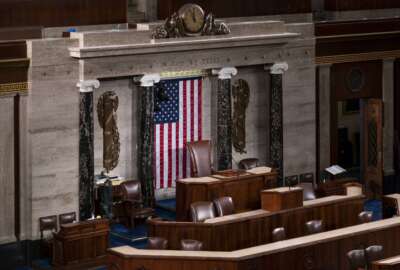Cyber Monday counterfeiting crackdown highlights agency collaboration
The Justice Department and the Immigration and Customs Enforcement led a government-wide effort to stem the flow of counterfeit products. The White House launch...
wfedstaff | June 4, 2015 2:32 pm
The largest online sting to stop the sales of counterfeit products in the government’s history happened because federal law enforcement officers are collaborating like never before.
“For the first time, we have everybody coming together. We are approaching this in a coordinated, joint fashion,” said John Morton, the director of the Homeland Security Department’s Immigration and Customs Enforcement directorate. “We are bringing our many different powers and authorities to bear. We have had a very profound impact in a very short period of time.” 
Last year, DoJ and ICE took out 82 sites selling fake products on cyber Monday. Since June 2010, agencies have seized the domain names of 350 websites.
“We would never be able to mount that kind of operation alone,” Morton said after an event at the White House Tuesday detailing new initiatives to stem the tide of counterfeit products. “We were able to do it because the FBI and ICE, the two largest criminal investigative agencies in the country, worked on it together. We divided up the sites, we investigated and then we worked with eight different U.S. Attorneys offices and the criminal division to go get seizure warrants for all of the sites.”
A growing problem
Morton credited the National Intellectual Property Rights Coordination Center for bringing not only ICE and the FBI closer together, but 14 other federal entities and three countries to work collectively on this growing problem.
Counterfeit products are not a new problem, but agencies are growing more concerned, especially as they find fakes in their supply chain. A recent Government Accountability Office report found in the Defense Department alone examples of about 1,800 cases of suspect counterfeit electronics being sold to the Pentagon. The total number of parts in these cases topped 1 million.
Sens. Carl Levin (D-Mich.) and John McCain (R-Ariz.) proposed and saw the Senate approve their amendment to strengthen DoD’s battle against counterfeit parts in the Defense Authorization bill Tuesday.
The provision:
- Prohibits contractors from charging DoD for the cost of fixing the problem when counterfeit parts are discovered.
- Requires DoD and its contractors whenever possible to buy electronic parts from original component manufacturers and their authorized dealers or trusted suppliers who meet established standards for detecting and avoiding counterfeit parts.
- Requires military officials and contractors who learn of counterfeit parts in the supply chain to provide written notification to the contracting officer, the DoD Inspector General and to the Government-Industry Data Exchange Program.
- Requires the DHS secretary to establish a methodology for the enhanced inspection of electronic parts after consulting with the Secretary of Defense as to the sources of counterfeit parts in the defense supply chain.
- Requires large defense contractors to establish systems for detecting and avoiding counterfeit parts, and authorizes reductions in contract payments to contractors who fail to do so.
- Requires DoD to adopt policies and procedures for detecting and avoiding counterfeit parts in its direct purchases, and for assessing and acting on reports of counterfeits.
- Requires DoD to define the term “counterfeit part,” and at a minimum to include in that definition previously used parts represented as new.
“This legislation will inject some much needed integrity, transparency and accountability into the defense supply chain, help customs officials intercept these counterfeits and ensure that prosecutors bring the full weight of justice down on those who traffic in military counterfeits,” McCain said in a statement. 
An interagency group led by the White House’s intellectual property enforcement coordinator Victoria Espinel is developing recommendations for the President to strengthen intellectual property enforcement.
Espinel also led an in-depth review of intellectual policies and laws, and issued a government-wide strategy to improve enforcement.
“Based upon the review we formulated core operating principles through which the U.S. government can more effectively increase the enforcement of intellectual property,” Espinel said Tuesday at the White House event.
She added the principles included improving how the government works together, legislative reforms, voluntary initiatives and public awareness.
Public service campaign
The Obama administration Tuesday kicked off a new public awareness campaign to help citizens understand the impact of counterfeit parts on the economy. The government created public service announcements to run on TV, radio and in print detailing how fake products affect jobs and people.
The intellectual property center is addressing the efficiency goal. While the former-Customs Service created it in 2000, Morton said the collaboration is better than ever before.
“The beauty of it is everyone is co-located,” he said. “We literally sit down together, go over leads, go over ideas, think of future enforcement initiatives, work with industry, receive tips from the public and we do it every week, we do it together and we focus our efforts in that fashion. It’s much more efficient and it’s much more powerful.”
In the past, Morton said each law enforcement agency pursued enforcement based on their silo, but rarely cross into other areas. The intellectual property center, however, breaks those artificial barriers.
He added while ICE runs the center from an administrative perspective, the 16 agencies share resources, including tools, technology and people.
RELATED STORIES:
Justice Dept. cracks down on sites selling counterfeits
Vendors under pressure to better secure IT supply chain
Interagency effort tries to protect federal supply chain
Copyright © 2024 Federal News Network. All rights reserved. This website is not intended for users located within the European Economic Area.
Jason Miller is executive editor of Federal News Network and directs news coverage on the people, policy and programs of the federal government.
Follow @jmillerWFED






